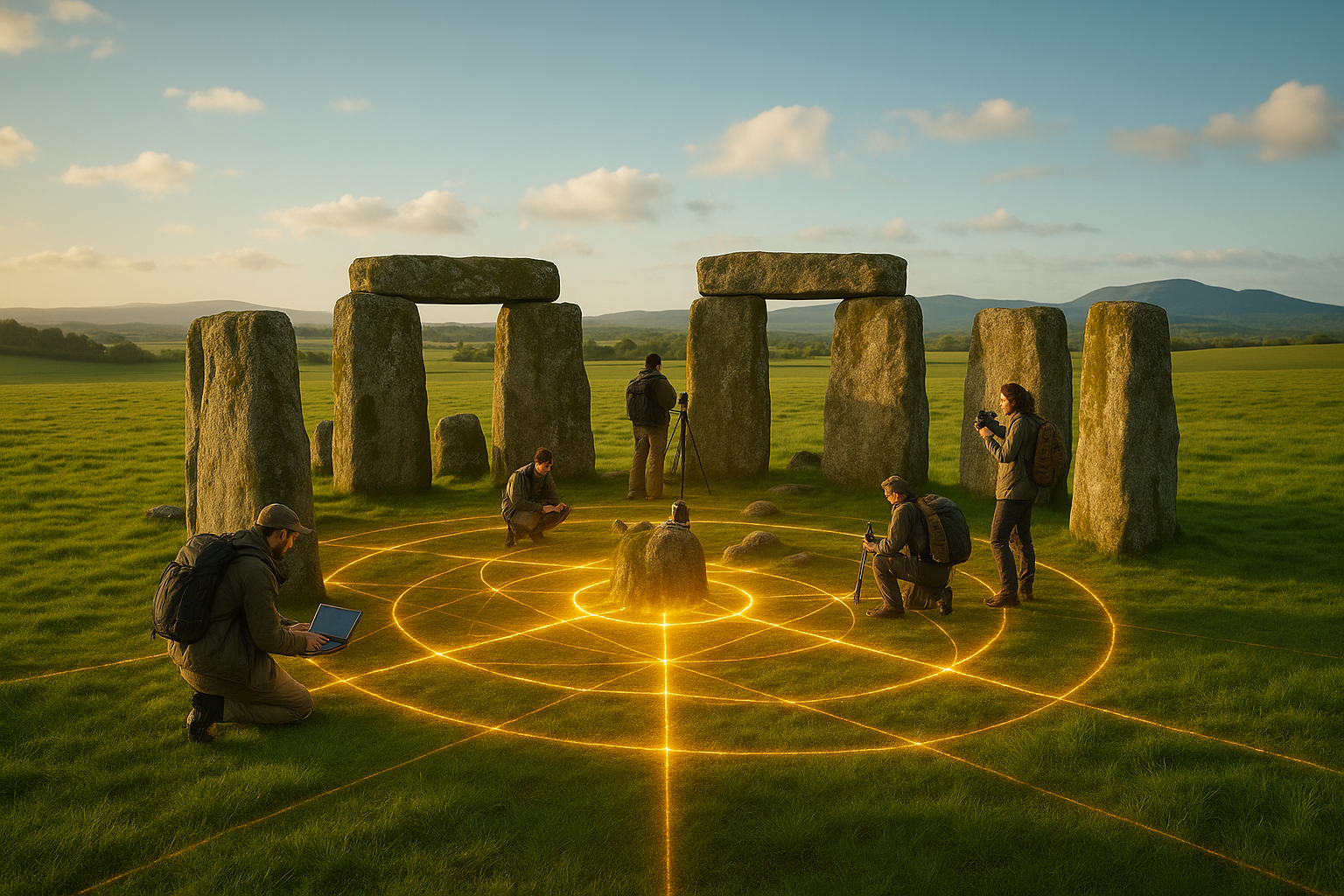In the heart of our planet lies a treasure trove of ancient wonders, each site whispering stories of civilizations long past. These sacred locations, whether it’s the enigmatic Stonehenge, the towering pyramids of Giza, or the mystical ruins of Machu Picchu, hold secrets that have fascinated scholars, adventurers, and dreamers for centuries. Yet, amidst the stones and artifacts, there’s an often-overlooked guardian that plays a crucial role in preserving these sites: plants. 🌿 While we typically associate plants with beauty and life, their role extends far beyond aesthetics. These green sentinels stand as silent protectors, weaving themselves into the very fabric of history and archaeology.
The intersection of botany and archaeology is a realm filled with intrigue and surprises. Plants are not merely passive witnesses to the march of time; they actively engage with and influence the preservation of historical sites. Their roots can both stabilize and destabilize ancient structures, their presence can prevent erosion, and their very existence can serve as a biological archive, offering insights into the climates and ecosystems of eras gone by. The careful study of plant life surrounding ancient sites can reveal changes in landscape use, shifts in climate, and even the agricultural practices of the people who once inhabited these lands. Such revelations transform our understanding of history, providing depth and context to the human stories etched in stone.
In this article, we will embark on a journey to explore the multifaceted roles that plants play in the protection and preservation of sacred sites around the world. We will delve into case studies where plant life has either safeguarded or threatened the integrity of ancient structures, examining both the beneficial and detrimental impacts of flora on archaeology. Furthermore, we will discuss the innovative conservation techniques that harness the natural power of plants, using them as allies in the quest to preserve our shared heritage. These strategies not only highlight the importance of interdisciplinary collaboration but also emphasize the necessity of viewing cultural preservation through a holistic lens.
The Role of Plants in Safeguarding Sacred Sites
Plants have long been integral to the preservation of sacred sites around the world. These sites, often rich in cultural and spiritual significance, rely on the natural environment for protection and sustainability. Plants play a crucial role in this ecological relationship by serving as guardians that shield ancient structures from environmental threats, while simultaneously preserving the cultural heritage these sites embody.
One of the primary ways plants protect sacred sites is through erosion control. Sacred sites, frequently located in natural settings such as mountains, forests, or riverbanks, face constant threats from erosion. Plants act as natural barriers, with their roots binding soil particles together, thus preventing soil erosion and maintaining the integrity of the land. For example, the ancient terraces of Machu Picchu are stabilized by native vegetation that anchors the soil, reducing the risk of landslides that could damage this UNESCO World Heritage site.
In addition to physical protection, plants contribute to the preservation of sacred sites by maintaining ecological balance. Many sacred sites are located in biodiversity hotspots where unique ecosystems thrive. Plants in these areas offer habitat and food for various species, supporting biodiversity and ensuring ecological stability. This balance is essential not only for the preservation of the site itself but also for the cultural practices associated with it. Many indigenous communities, for example, rely on the biodiversity of sacred forests for traditional rituals and medicinal practices, which in turn helps sustain their cultural heritage.
Moreover, plants hold symbolic and spiritual significance in many cultures, further enhancing their role in the preservation of sacred sites. Trees such as the Bodhi tree in Buddhism or the oak tree in Celtic traditions are revered for their spiritual importance. These plants often become central to the spiritual landscape of a site, attracting pilgrims and visitors who seek spiritual connection and solace. The presence of these sacred plants can help maintain the cultural significance of a site, ensuring that it remains a place of reverence and spiritual renewal for future generations.
Examples of Plant-Based Protection Strategies
Different sacred sites around the world employ a variety of plant-based strategies to protect and preserve their unique environments. Understanding these strategies not only highlights the importance of plants in cultural preservation but also offers insights into sustainable practices that can be applied globally.
A prominent example is the use of sacred groves in India, where certain forests are protected due to their spiritual significance. These groves are often untouched by human activity, allowing plants to thrive and create a natural buffer that protects the soil and water resources. The local communities, recognizing the spiritual and ecological value of these groves, enforce strict conservation practices that have successfully preserved the biodiversity of the region for centuries.
Another example can be found in the Andes, where indigenous practices involve the cultivation of traditional crops such as quinoa and amaranth around sacred sites. These crops are adapted to the harsh mountain environment and contribute to soil fertility and moisture retention. This agricultural practice not only sustains local food traditions but also enhances the ecological resilience of the area, protecting ancient sites from environmental degradation.
Integrating Modern Science and Traditional Knowledge
The integration of modern scientific approaches with traditional knowledge has become increasingly important in the effort to preserve sacred sites. By combining these perspectives, we can develop innovative strategies that leverage the strengths of both fields to enhance the protection of these culturally and historically significant locations.
Modern technology, such as remote sensing and geographic information systems (GIS), offers valuable tools for monitoring the health of ecosystems surrounding sacred sites. These technologies can help detect changes in vegetation, soil erosion, and other environmental factors that may pose a threat to the site. When paired with traditional ecological knowledge held by indigenous communities, this data can inform conservation strategies that are both scientifically sound and culturally respectful.
For example, in the Amazon rainforest, indigenous tribes have worked alongside scientists to develop conservation plans that protect sacred sites while promoting sustainable land use. By mapping sacred areas and identifying key plant species, they have been able to implement practices that maintain the ecological integrity of these sites and support the livelihoods of local communities. This collaboration highlights the potential for blending scientific methods with traditional practices to achieve holistic and sustainable conservation outcomes.
- Remote sensing technologies for monitoring vegetation health.
- GIS tools for mapping and identifying sacred plant species.
- Collaboration between scientists and indigenous communities for sustainable conservation.
Case Study: The Role of Medicinal Plants in Sacred Sites
Medicinal plants often play a pivotal role in the preservation of sacred sites, offering both ecological benefits and cultural significance. These plants are not only vital for the health and wellbeing of local communities but also serve as key components of traditional rituals and spiritual practices.
In many cultures, sacred sites are home to a rich diversity of medicinal plants that are used in healing practices. These plants are often considered sacred themselves, believed to possess unique healing properties that connect the physical and spiritual worlds. The protection of these plants is therefore seen as essential for the maintenance of cultural traditions and the spiritual health of the community.
The African country of Ethiopia provides a compelling case study of this phenomenon. In Ethiopia, sacred forests known as “church forests” surround many of the country’s ancient churches. These forests are home to a diverse array of medicinal plants that are integral to traditional healing practices. Local communities, guided by religious and cultural beliefs, actively protect these forests, ensuring the continued availability of these vital resources.
Incorporating traditional knowledge about medicinal plants into conservation efforts can enhance the protection of sacred sites and support the health of local ecosystems. This approach recognizes the interconnectedness of cultural and ecological values, promoting a more holistic understanding of what it means to protect and preserve sacred sites.
The Future of Sacred Site Preservation
As we look to the future, the role of plants in protecting sacred sites will become increasingly important in the face of climate change and other environmental challenges. By fostering an appreciation for the ecological and cultural significance of these sites, we can work towards more sustainable and effective conservation strategies.
Education and awareness-raising initiatives play a key role in this effort. By sharing knowledge about the importance of plants in preserving sacred sites, we can inspire greater appreciation and respect for these places among both local communities and the global public. This, in turn, can lead to increased support for conservation efforts and more effective policy measures to protect these invaluable cultural treasures.
Furthermore, supporting the rights and knowledge of indigenous peoples is crucial for the successful preservation of sacred sites. Indigenous communities often possess deep ecological knowledge and a profound spiritual connection to their ancestral lands, making them invaluable partners in conservation efforts. By respecting their rights and involving them in decision-making processes, we can ensure that conservation strategies are both culturally appropriate and ecologically effective.
- Educate yourself and others about the importance of plants in preserving sacred sites.
- Support organizations and initiatives that work towards the conservation of sacred sites and indigenous rights.
- Advocate for policies that protect sacred sites and recognize the cultural and ecological value of these places.
- Promote sustainable tourism practices that respect the cultural and spiritual significance of sacred sites.
To further explore the intricate relationship between plants and sacred sites, check out this informative video on YouTube: Guardians of the Sacred – Channel: National Geographic. This video provides a deeper understanding of how plants contribute to the preservation and protection of sacred sites around the world.

Conclusion
In conclusion, the exploration of how plants serve as guardians of sacred and ancient sites reveals a profound intersection between nature and human history. Throughout the article, we have journeyed through various examples that illustrate the symbiotic relationship between plants and the preservation of cultural heritage. From the mighty banyan trees standing tall around ancient temples to the humble mosses that protect ancient rock art from erosion, plants play a pivotal role in maintaining the integrity and sanctity of these sites.
One of the key points discussed is the ability of plants to prevent erosion, which is crucial in preserving ancient structures. Vegetation helps to stabilize the soil, reducing the impact of natural elements that could otherwise degrade these precious sites over time. Furthermore, plants contribute to the microclimate around these sites, regulating temperature and moisture levels, which in turn helps in slowing down the deterioration of historical artifacts.
Another significant aspect we covered is the cultural symbolism of plants in many of these sacred sites. Often, specific species are considered sacred or are used in rituals and ceremonies, linking the spiritual practices of ancient civilizations to the natural world. This highlights the intertwined relationship between humans and nature, showcasing how plants are not only physical protectors but also spiritual custodians.
Moreover, the article emphasizes the importance of biodiversity. The preservation of ancient sites often goes hand in hand with the conservation of plant species, many of which may be rare or endemic. Protecting these plants not only aids in the preservation of cultural heritage but also supports broader environmental conservation efforts.
The article also addresses modern challenges, such as climate change and urban development, which threaten both the plant life and the ancient sites they protect. By understanding the protective role plants play, conservation efforts can be better directed to ensure both natural and cultural preservation.
In reinforcing the importance of this topic, it is crucial to recognize that plants are indispensable allies in our quest to preserve history. They are silent sentinels, safeguarding our shared human legacy. As stewards of both nature and culture, it is our responsibility to protect these natural guardians.
I encourage you, dear reader, to reflect on how you can contribute to the preservation of these invaluable sites. Whether through supporting conservation organizations, participating in community efforts, or simply spreading awareness, every action counts. Share this knowledge with others, engage in discussions, and inspire collective action. 🌿
Let us work together to ensure that future generations can continue to marvel at these ancient sites and the natural guardians that protect them. 🌱
For further reading, you can explore resources such as the World Heritage Centre and the International Union for Conservation of Nature, which provide more insights into the conservation of cultural and natural heritage.
Thank you for joining me on this enlightening journey. Your engagement and commitment to preserving our planet’s rich history make a difference. Let’s cultivate a future where nature and heritage thrive together. 🌍
Toni Santos is a visual storyteller and symbolic naturalist whose creations explore the hidden ecologies and forgotten bonds between humans and nature, as whispered through ancient lore. Through an intuitive and myth-sensitive lens, Toni reveals the sacred choreography between flora, fauna, and human spirit — a world where trees once spoke, rivers remembered, and every herb carried a secret name.
His journey is rooted in the esoteric — in the rituals of forest-dwellers, the botanical codes of shamans, and the unspoken pacts that shaped how ancient peoples lived in deep, reciprocal harmony with the natural world. From sacred groves to serpent-guarded springs, each of Toni’s works reflects a symbolic relationship long obscured by modern forgetfulness.
With a background in visual design and ancestral aesthetics, Toni merges storytelling with sacred ecology. His pieces don’t simply illustrate — they channel. Drawing from myth, mysticism, and lost herbal traditions, he crafts visuals that resonate with the old wisdom: that nature is not background, but kin.
As the creative spirit behind Vizovex, Toni shares collections, visual studies, and articles that illuminate the occulted connections between human life and the wild world. His work calls on us to remember — not just with the mind, but with the senses and the soul — the profound dialogues our ancestors once had with earth, plant, and animal.
His work is a tribute to:
The mythic language of trees, stones, and roots
Forgotten pacts between healers and the wilderness
The sacred knowledge carried in nature’s unseen patterns
Whether you’re a seeker of ancient plant-lore, a mystic attuned to seasonal cycles, or simply someone who hears the forest speak, Toni welcomes you to wander a space where symbolism, nature, and spirit entwine — one myth, one leaf, one vision at a time.





